Disasters
Whitehaven Mining Disasters
To be classified as a disaster, an accident or explosion at a mine had to claim at least ten lives. The Whitehaven coal field suffered many disasters and innumerable smaller accidents. It has been estimated that over 1700 men, women, and children have lost their lives while mining coal in the Whitehaven collieries.
Between 1880 and 1910, over 1000 fatalities occurred every year in British coal mines. An average of four miners killed and 517 injured every day. In 1910 the national fatality figure rose to 1818 killed. Of these, 501 died in explosions, 658 through falls of ground, and 286 through haulage accidents. There were two major disasters that year, an explosion of firedamp at Wellington Pit, Whitehaven, killed 136 men and boys, and an explosion of coal dust at Hulton, in Lancashire, killed 344.
The Wellington Pit disaster remains as Cumbria’s worst mining accident. The most disastrous explosion in Europe occurred in Courrieres, France in 1906, when 1,100 men and 98 horses were killed, when a blown out shot ignited coal dust. The world’s worst disaster occurred in 1942, in China. The Honkeiko Colliery coal dust explosion claimed 1,549 miners.
Although these explosions claimed many lives, they represent only a fraction of the accidents and explosions that have occurred in the Whitehaven mines. The local newspapers are filled with such reports throughout the 1800′s and early 1900′s. The death of two men may only have been eligible for a small article and the death of one man through a fall of ground, scarcely a mention. Harrowing as these reports may be, they can do little to convey the full misery and suffering. The news that the families bread winner, or winners as was so often the case, had perished, must have only been the beginning of the suffering. The widow’s pension of 2 shillings was considered high in 1839, but must have been hard stretched to raise a family. Even “Lame persons doing nothing” received 5 shillings a week in the 1802 payroll for the Howgill Colliery. Even without the frequent accidents, the conditions underground were horrendous.
It would be unthinkable today to deliver mutilated remains in a straw filled cart or to take home the broken body of a child who was not expected to live through the night. These however, due to the high concentration of methane in Whitehaven mines, were regular occurrences.
The first Coal Mines Act of 1843 began to pave the way to safer pits. It contained only 5 regulations including the total prohibition of boys under ten, or female labour, working underground. It also appointed Official Inspectors of Mines (now the HM Inspectorate of Mines, part of the Health & Safety Executive). This legislation and further acts that were to follow gradually improved conditions and the safety of coal mines. This now means that British Coal Mines are amongst the safest in the world.
HAIG PIT DISASTER – 5TH SEPTEMBER 1922
It was 5 am on any normal day when William Weightman, the Deputy in Charge of the Six Quarters Seam, was working overtime to cover for another man on holiday. The report book showed that gas had been detected in the North District, and three areas were fenced off, but when Weightman went down, earlier that evening, the areas were reported to be clear. Fourteen men entered the South-west District including the Deputy Daniel McKenzie & thirty-eight men went to the Six Quarters North District. A further nineteen went to the drifts and eleven to the main haulage road and shaft bottom. At 7 am, Carl Brewster, a Shot Firer, descended & went to the North District, Also in the mine was Under Manager, Alexander Millar.
A cross section of Moore’s Place where the shot being fired by Weightman had released a pocket of gas (a blower) which had ignited, causing the explosion. The Chief Inspector of Mines stated in his report to Parliament “Weightman should certainly have the benefit of the doubt in the absence of direct evidence that it was his fault.”.
Just before nine, the Banksman, Alexander Pitblade, noticed a cloud of dust coming up the downcast shaft {No.4 shaft}. The agent, Robert Steel, was informed at William Pit, and after calling the Mines Rescue, set off for Haig along with Mr Brodie, William Pit Manager, and Mr Cook, the Inspector of Mines.
When the explosion struck, Millar, the Under Manager and Trevaskis, a Rope splicer, were standing underground near the Compressor House, when they were knocked off their feet by a blast coming from the North District, Six Quarter Seam. Trevaskis suffered broken ribs but Millar, more or less unhurt, moved in bye until he came across the first dead body, a young man called Thomas Telford, aged 19. He had been thrown with great force and was lying between some tubs and the side wall. In the South-west District, the men knew there had been an explosion and were making their way out. By the time Steel, Brodie, Cook and Thompson arrived, they could hear Millar calling for help, and found him, near unconscious, 120 yards down the drift. They dragged him back to the junction with the help of John Rothery and Mr Kilpatrick, who had made their way to the scene. The search resumed and a Hewer, named William Carter, was found dying under empty tubs, de-railed at No.1 crossing.
Cook and Steel managed to reach the Six Quarters Junction, and after deciding there was no risk of fire, started the fan at 10.30 am. The air was full of afterdamp (mainly Carbon Monoxide) and a white vapour and they decided all must be dead in the area of the explosion. Steel, Brodie and Millar were all taken to the surface suffering from the effects of gas and were taken to the local hospital. A halt in the rescue attempts was called until repairs could be carried out to improve the atmosphere.
By early afternoon, the repairs were completed and the air was making it’s normal course. The Rescue party moved in, recovering dead bodies and making further repairs as they went. Afterdamp was still causing problems, with many rescuers having to be helped back to the shaft top, some unconscious, but things were improving with the erection of further brattices (planks or a wooden frame with a canvas cover to control air circulation). By 3 am on the 6th, 22 hours after the shift had entered the mine, the bodies of 25 men had been recovered. The remainder had been buried by roof falls and their bodies were not recovered until the 10th September.
A diagram of the area at the source of the explosion. The cross section above (top right) is marked M on this drawing
…..the relatives intermingled in the huge crowd at the pit head, displayed wonderful fortitude and optimism, and continued to hope for the best, as only relatives can. Not until the ever-increasing death roll commenced at four o’clock, was the courageous point of view shaken, and then the inevitable was accepted with bowed heads. Non today had a more truly heart breaking interest in the disaster than the Rev F.K.Fell, Vicar of Holy Trinity Church, Whitehaven. Among the men who the rescue workers are gallantly labouring to reach, was his son, Michael, a promising and popular young man, home on vacation from Armstrong College, Newcastle, where he had been studying in preparation for an appointment as Colliery Manager. He had, however, to have certain actual experience of life and working conditions down a pit, and to make the most of his holiday, had gone down the Haig shaft, where he had soon become a favourite with his fellow temporary workers.”
Whitehaven News, 6th September 1922
The inquest was formally opened in the Power House (the room next to No.4 engine hall), with the bodies being kept in the cellars below. Eight were in handsome coffins with brass mountings, but the majority were covered up with the exception of their bandaged faces, which were exposed. The dead were identified as:-
| Bennett, John, aged 26, Hewer, cause of death: CO poisoning; address: 28, Arrowthwaite | |
| Brewster, John Carson, aged 39, Shotfirer, cause of death: violence of explosion; address: 17, Lonsdale Place, Whitehaven | |
| Carter, William, aged 26, Hewer, cause of death: violence of explosion, burns, shock, CO poisoning (?); address: 30, Thwaite Ville | |
| Casson, John, aged 37, Hewer, cause of death: CO poisoning; address: Low Harras Moor | |
| Cooper, Thomas Henry, aged 28, Hewer, cause of death: suffocation, CO poisoning; address: 28, Auction Yard, New Town | |
| Corlett, Thomas, aged 58, Shifthand, cause of death: burns, shock, CO poisoning; address: Birley Court, Duke Street; identified by nephew Thomas Corlett Robson | |
| Coulter, Samuel, aged 28, Hewer, cause of death: CO poisoning; address: 52, Main St, Hensingham; identified by brother John Robert Coulter | |
| Denvir, Richard, aged 58, Shifthand, cause of death: violence of explosion, CO poisoning; address: 2, Low Road, Whitehaven | |
| Denwood, Robert, aged 21, Hewer, cause of death: violence of explosion, CO poisoning (?); address: 13, Quay Street; identified by mother Elizabeth Denwood | |
| Fell, Douglas James Michael, aged 20, Mining Student, cause of death: suffocation, CO poisoning; address: Holy Trinity Vicarage, Whitehaven | |
| Gilhooley, Thomas, aged 39, Hewer, cause of death: CO poisoning; address: 40, Keekle Terrace, Hensingham; identified by father Thomas Gilhooley | |
| Goulding, Henry, aged 32, Hewer, cause of death: suffocation, CO poisoning; address: 2, Ravenhill | |
| Graves, James, aged 46, Shifthand, cause of death: burns, shock, CO poisoning; address: Goosebutts, Hensingham; identified by son James Graves | |
| Haig, Thomas, aged 37, Hewer, cause of death: burns, shock; address: 2, Cook’s Court, Scotch Street; identified by widow Mary Elizabeth Haig | |
| Hellon, Leonard Ixon, aged 27, Hewer, cause of death: burns, shock; address: 3, Thwaite Ville; identified by Moses Huddleston Tyson | |
| Hope, William, aged 25, Hewer, cause of death: suffocation, CO poisoning; address: 10, School House Lane; identified by brother Thomas Hope | |
| Kirkpatrick, John, aged 32, Hewer, cause of death: CO poisoning, cause of death: suffocation; address: 1, Hill’s Place, Church Street; identified by father Robert Kirkpatrick | |
| McAvoy, Sylvester, aged 34, Hewer, cause of death: burns, shock, CO poisoning; address: 29, Thwaite Ville; identified by uncle James Harvey | |
| McCreadie, George, aged 47, Hewer, cause of death: CO poisoning; address: 4, Thwaite Ville; identified by son Joseph McCreadie | |
| McCreadie, Gordon, aged 17, Hewer, cause of death: suffocation, CO poisoning; address: 4, Thwaite Ville; identified by brother Joseph McCreadie | |
| McCreadie, Robert Routledge, aged 19, Hewer, cause of death: violence of explosion; address: 4, Thwaite Ville; identified by brother Joseph McCreadie | |
| McDowell, Robert, aged 44, Hewer, cause of death: CO poisoning; address: High Hensingham | |
| McDowell, Thomas, aged 19, Trailer, cause of death: burns, shock, CO poisoning; address: Streeton’s Terrace, Hensingham; identified by brother in law Robert Knox | |
| Moore, John, aged 25, Hewer, cause of death: burns, shock, CO poisoning; address: 10, Bransty Road; identified by father in law John High | |
| Moore, Joseph, aged 29, Shifthand, cause of death: violence of explosion, CO poisoning (?); address: 22, Thwaite Ville; identified by father James Moore | |
| Moore, Thomas, aged 29, Hewer, cause of death: burns, shock; address: 3, Garden Villas, Hensingham | |
| Murphy, Bernard, aged 24, Hewer, cause of death: burns, shock; address: 56, Bowthorn Road, Cleator Moor; identified by father Bernard Murphy | |
| Osbourne, Isaac, aged 26, Hewer, cause of death: suffocation, CO poisoning; address: Crookdale, Brayton, Buried: Bromfield Churchyard | |
| Parkinson, George Stevenson, aged 26, Hewer, cause of death: burns, shock, CO poisoning; address: Low Harras Moor; identified by widow Mary Jane Parkinson | |
| Pattinson, John, aged 36, Hewer, cause of death: violence of explosion; address: 13, Williamson’s Lane, Hensingham | |
| Powe, Albert, aged 19, Shifthand, cause of death: burns, shock, CO poisoning; address: Low Harras Moor; identified by father Philip Powe | |
| Robinson, Thomas, aged 29, Hewer, cause of death: burns, shock, CO poisoning; address: 53, Main St, Hensingham | |
| Shepard, Albert, aged 39, Hewer, cause of death: burns, shock, CO poisoning; address: 135, Main St, Parton; identified by Ernest Shepard | |
| Sparks, Jackson, aged 19, Hewer, cause of death: burns, shock, CO poisoning; address: 4, Williamson’s Lane, Hensingham | |
| Sparks, William John, aged 23, Hewer, cause of death: burns, shock, CO poisoning; address: 4, Williamson’s Lane, Hensingham | |
| Telford, Thomas Parker, aged 19, Shifthand, cause of death: violence of explosion; address: 7, Low Harras Moor; identified by father John James Telford | |
| Tyson, Moses Huddleston, aged 24, Hewer, cause of death: suffocation, CO poisoning; address: 3, Thwaite Ville; identified by father Moses Huddleston Tyson | |
| Watson, George, aged 37, Hewer, cause of death: violence of explosion; address: 5, Brookbank, Hensingham | |
| Weightman, William, aged 32, Deputy, cause of death: burns, shock; address: 16, Thwaite Ville; identified by father in law Thomas McKenzie |
“A glance at the list of addresses above indicates the cruel blow delivered against the manlihood of Thwaiteville, the little Arrowthwaite colony of Army huts, tenanted by colliery employees, which sprang into existence since the war. In a day, nine of its men had been recorded as dead with the probability of more to follow. The hamlet is in the deepest mourning, it’s inhabitants (with the exception of the children who do not understand the calamity which has befallen the community) talking in hushed voices. Probably the most tragic case is that of the deaths of George McCreadie and his two sons, Robert and Gordon. All lived in the same hut in Thwaiteville and even in the war, no wife sustained such a crushing blow in a single day.The widow is left with five children.
Yesterday, our Reporter called on some of the men who were down the mine when the explosion occurred but escaped. In some instances, their re-collection of what occurred after the explosion was distinctly hazy. Our Reporter called up on Mr T. Travaskis, Rope Splicer, who resides in Catherine Street. Mr Tervaskis escaped with his life but is severely injured. He has three ribs broken, is suffering from internal injuries, has sustained severe wounds on the back of his head and forehead, and has been burned down the left side. Our Reporter found Mr Trevaskis lying in a clean, comfortable, well-furnished bedroom, where he is being nursed by his devoted wife. He was much to ill to talk, but managed, speaking slowly, and with an effort, to tell our representative that the explosion sounded, at the place where he was working, “like a gun shot”. After that he knew no more. From other sources, our representative gathered that Mr Trevaskis was found un-conscious, his head lying over a tub”.
Whitehaven News 7th September 1922
The enquiry heard evidence regarding the strong feeder of firedamp (a release of methane from the coal strata) found discharging from the fissure at Moore’s Place. Questions were raised about the safety procedures adopted by Weightman and Brewster, but it was thought most unlikely either would have fired shots into a face if there were any suspicion of a blower behind it.
A youth named Joyce was described as having a miraculous escape. He was on the telephone, in a manhole on the main road, when the explosion ripped past. This alone, saved him from certain death. A Mayors fund was opened to “place the relatives beyond the reach of poverty” and money poured in from around the country. A letter and 20 shillings was received from a mother in Scotland for Mrs McCreadie because her own two sons, who had been killed in the war, bore the same names as the McCreadie boys, Robert and Gordon.
———————————————————————————————————————————————-
HAIG PIT DISASTER – 12th FEBRUARY 1928
After the explosion on 13th December 1927, which killed four men, the 800 miners at Wellington Pit returned to work on 3rd January. Haig, however, still lay idle along with 1100 men. Doors were made in some of the Stoppings on the 9th February in preparation for exploration work. Samples of air, taken through pipes in the stoppings earlier in the week had been analysed and showed the fire was probably extinguished. Checks on the far side of the main stopping were made using Canaries, which revealed a satisfactory state of affairs.
Saturday was chosen to resume the search for the body of Harold Horrocks. Permission was gained from the inspectors and a party of 24, consisting of two rescue teams, Mines Inspectors, Officials and Colliery Managers, entered the mine. On reaching the stoppings, the Canaries seemed unaffected by gas, so the first rescue team proceeded into the area of the fire at No.1 Dilly, leaving the others, who had no breathing
appartus, behind. They came back with pieces of coke and charred wood and reported that the fire was out and they could find no heat. At this, the rest of the party entered the area. The Deputies cleared de-railed tubs and Electrical Engineers restored telephonic communication with the surface. At the seat of the fire, it was found that 25 yards of the coal face was a mass of coke and the props had been charred to a depth of two inches.
At 11 pm, with work progressing well, Messrs Johnson, Foster, Durham, Morgan and others returned to the surface, while refreshments were conveyed to the remainder. Shortly before midnight, the rescue team returned to the entrance of Development District to recharge their breathing apparatus. A section of the party headed by Mr Steel, the Works Manager, entered the Engine Dip in search of Mr Horrocks, leaving five deputies to clear up falls in the main road.
Robert Steel (middle), the Works Manager, seen with two men in rescue equipment. As the shaft top supports are made of wood, this photograph was probably taken at Wellington Pit.




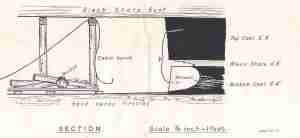

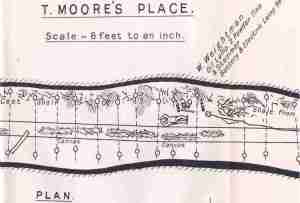
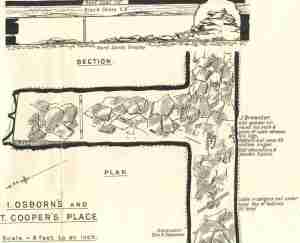

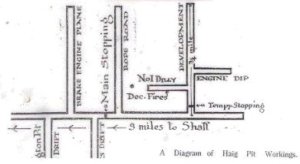
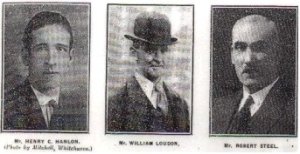
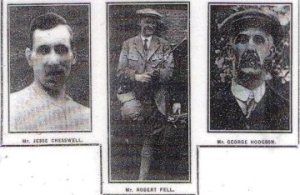

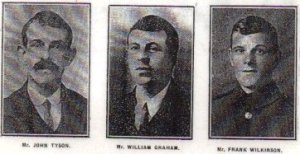
Pingback: Proposed West Cumbria Coal Mine Near Sellafield Nuclear Site: Comment Deadline July 10th; Sample Letter; Leaflet to Print-Share | Mining Awareness +
How mini tunnels did Haig pit have in Whitehaven Cumbria uk
Where did the burials of the men killed in the 1922 explosion take place. My grandfather Sylvester McAvoy was one of them
It would of been in there local cemetery depending on what faith the men where & witch church they belonged to/ there home town hope that helps.
I’ve been looking in to a disaster that happened maybe in the 70s/80s. My grandfather was trapped in there and survived. Was just wondering if there is any details about what happened.
Yes I am too.. my grandfather Joseph William stewart was killed in haig in 50s and cant find anything out about his death
my great grandfather Hugh Mackenzie is one of those bodies never recovered
My grandfather Peter Burdess was one of the mine inspectors who died on 12 Feb 1928. He was from Newcastle and left my grandmother with a 3-year old (my mum) and a 6 week old boy, another Peter. The family settled in Durham City after his death.
Simon Footer
I worked at Haig in the 1980’s, I’ve stood at the bricked up entrance. I wasn’t told of what had happened at first. Though I knew something had and the feeling of sadness. I was told after a week, these poor souls! I shall never forget them or what happened to them. I bring flowers to the monument at Haig whenever I visit. These brothers must never ever be forgotten! The mine may have closed but they’re still “on shift.” RIP my brothers, RIP.
yes, i was always told about my grandmother, Catherine gwendoline butcher who married a Southward, being involved in some capacity in the rescues in 70s/ 80s mabye, then some mention to a legislation or something that came in for safety. she was one of the head nurses or matron or something like that at the time.
she helped with foot cleanising to stop infection being introduced there too.